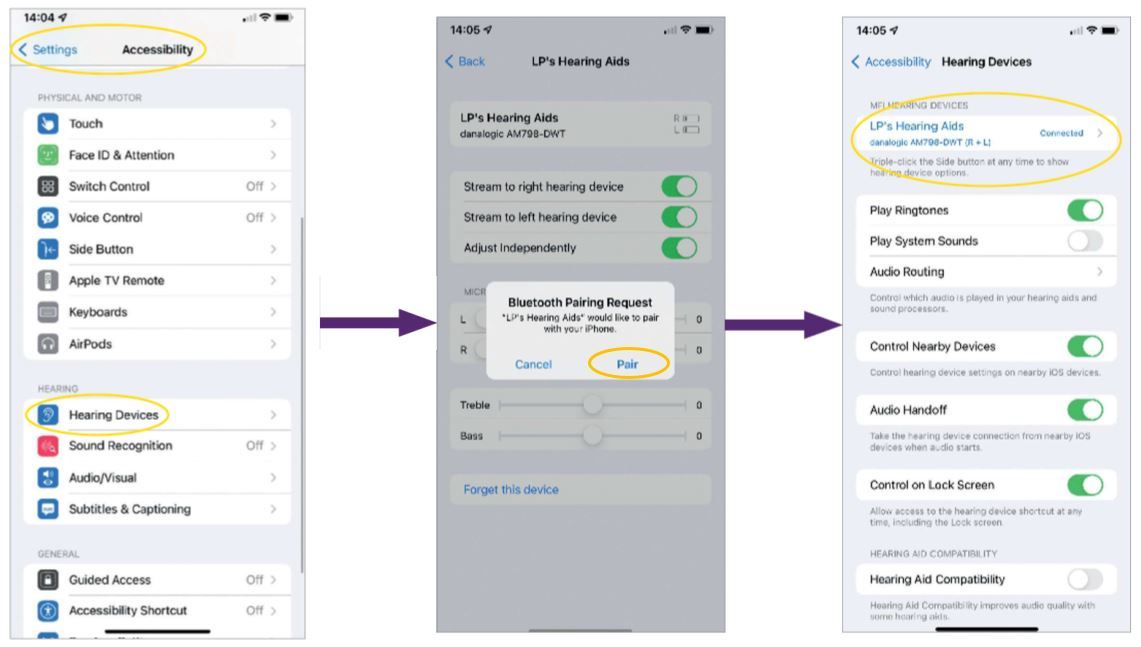NHS Bluetooth Hearing Aids
Bluetooth compatible hearing aids are now available through the NHS. Use Bluetooth to connect your hearing aids to your compatible smartphone, tablet & more.
Bluetooth compatible hearing aids are now available through the NHS. Use Bluetooth to connect your hearing aids to your compatible smartphone, tablet & more.
danalogic Extend, Ambio Smart and Actio hearing aids are Bluetooth-enabled to allow direct streaming. This means you can connect your hearing aids wirelessly to your smart device to enjoy calls, music, and audio directly through your hearing aids. So whether you’re catching up with a friend or listening to a news app, you can feel confident that you’ve heard every word.
Bluetooth capability also removes the need for wearing headphones – you can discreetly listen to music or watch videos in public and no one will know what or who you’re listening to.1
Check if your smart device is compatible for Bluetooth streaming now
danalogic GN | Smartphones compatibility with Danalogic hearing aids
The future of connectivity and assistive listening technology is here. Auracast™ broadcast audio transforms audio experiences with the latest Bluetooth® technology and Auracast enabled hearing aids.
What is Auracast and Bluetooth LE Audio?
Bluetooth Low Energy (LE) Audio is the next generation of Bluetooth wireless connectivity
You probably already use Bluetooth technology in your daily life, streaming music, TV audio or calls. The new Bluetooth LE Audio offers the clearest sound, lowest latency and lowest battery consumption for all-day streaming. In the next few years, it is expected there will be 3 billion Bluetooth LE Audio enabled devices including mobile devices, computers and TVs.10
Auracast broadcast audio gives great new possibilities to stream audio at public places
Auracast broadcast audio, the next generation of assistive listening technology, is being rolled out in public places globally and in everyday devices to transform audio experiences and make hearing inclusive.
Our danalogic Extend hearing aids are Auracast™ ready - danalogic GN | danalogic Extend

Most Bluetooth-enabled Apple and android devices are compatible with danalogic NHS hearing aids. If you are unsure, you can ask your audiologist or check if your device is compatible.
If your smartphone or tablet is not compatible but is Bluetooth-enabled, you can still stream wirelessly from it to your danalogic NHS hearing aids using a Phone Clip+. This is a small electronic device that connects to your smart device and hearing aids to stream the sound and allows for two way calling. In addition to steaming audio, the Phone Clip+ can be used as a remote control. So you can adjust the volume or scroll between programs on your danalogic NHS hearing aids, without even touching them.2
Your audiologist may refer to the Phone Clip+ as a ‘wireless accessory’. It’s part of a whole family of wireless devices that can help you to get the best out of your NHS hearing aids.
Before you can start using the Bluetooth features of your danalogic NHS hearing aids you need to link them with your device. This is often referred to as ‘pairing’. To pair your hearing aids to an Apple device (such as an iPhone or iPad), please follow these instructions:1,3
Please note, these images show the screens displayed on iOS 13 or newer apple devices only:

Before you can start using the Bluetooth features of your danalogic NHS hearing aids you need to link them with your device. This is often referred to as ‘pairing’. To pair your hearing aids to an android device, please follow these instructions:1,3
If one or both of your hearing aids have been replaced, you will need to re-pair them to your smart device.
For Apple products:
For Android products:
As with any new technology, people may feel nervous about using Bluetooth until it has been categorically proven as “safe”. Over the last 20 years scientists have been researching the effects of using mobile phones and other devices that use radio waves, a type of electromagnetic radiation.4,5 When we hear ‘radiation’ our minds may jump to UV rays in sunlight or x-rays, and the potential risks associated with them, however, there are many types of radiation. X-rays are high energy ‘ionizing’ radiation, which can cause damage to cells in the body. Bluetooth on the other hand is much lower energy ‘non-ionizing’ radiation – in fact, it has a billion times less energy than ionizing radiation!5
Due to Bluetooth’s low energy, scientists have advised that is does not cause harm to people. Studies in large groups of people have shown that there is not an increased risk of cancer if you are exposed to non-ionizing radiation.5,6 Mobile phones also use non-ionizing radiation, but research has shown that they emit less of this when being used with wireless/Bluetooth headsets.7f
A traditional hearing aid has a microphone, a processor, a receiver and a power source to allow sounds to be transmitted to users. The sound from the microphone is digitally processed and specifically amplified in order for the hearing system to effectively convert the sound signal into a neural impulse that can then be processed by the brain.
Bluetooth hearing aids provide the same functionality as traditional hearing aids - but Bluetooth enables them to double up as custom audio devices. This allows Bluetooth hearing aid users to enjoy a streamlined all-in-one listening experience - without having to switch out hearing aids for headphones.
Life is so much more enjoyable when you can hear what’s going on around you. If you have been diagnosed with a hearing loss your audiologist may recommend that you try wearing one or two NHS hearing aids.8,9 Danalogic are proud to provide two types of Bluetooth-enabled, digital NHS hearing aids:
Our first rechargeable NHS portfolio to use the brand-new Bluetooth Low Energy Audio Protocol and be Auracast™ ready. The latest edition to the Danalogic family:
This Bluetooth-enabled digital hearing aid, features:
The original danalogic Bluetooth-enabled digital hearing aid, designed exclusively for the NHS, featuring:
Our support and care page provides handy user guides and video tutorials for all danalogic NHS hearing aids, accessories, and apps. So whether you’re unsure about how to use your NHS hearing aid, looking for top tips to maintain it, or want step-by-step instructions to pair a wireless accessory, we’ve got it covered.
If you would like more information about danalogic NHS hearing aids, wireless accessories and apps, or to book a demonstration please get in touch. You can also explore our Professional Portal to access useful support materials.
1. DanalogicGN. Danalogic Ambio Smart; Your new Bluetooth hearing aids. UK09.03 A 01.2022. Available at: https://www.danalogic.co.uk/up... (accessed April 2024);
2. DanalogicGN. User Guide Phone Clip+. 400227245GB-18.07-Rev.B. Available at: https://www.danalogic.co.uk/up... (accessed April 2024);
3. DanalogicGN. Get connected quick guide. M102849GB-21.03-Rev.A. Available at: https://www.danalogic.co.uk/up... (accessed April 2024);
4. NHS 111 Wales. Mobile phone safety. July 2021. Available at: https://111.wales.nhs.uk/Mobil... (accessed April 2024);
5. US Food and Drug Administration. Radio Frequency Radiation and Cell Phones. February 2020. Available at: https://www.fda.gov/radiation-... (accessed April 2024);
6. Cancer Research UK. News digest – online prostate cancer predictor, NHS waiting times, breast cancer rulebook and Bluetooth headphones. March 2019. Available at: https://news.cancerresearchuk.... (accessed April 2024);
7. Division of Environmental and Occupational Disease Control, California Department of Public Health. How to Reduce Exposure to Radiofrequency Energy from Cell Phones. Available at: https://www.cdph.ca.gov/Progra... (accessed April 2024);
8. National Institute on Deafness and Other Communication Disorders. Hearing Aids. July 2015. Available at: https://www.nidcd.nih.gov/site... (accessed April 2024);
9. Royal National Institute for Deaf People (RNID). Get your hearing tested. Available at: https://rnid.org.uk/informatio... (accessed April 2024).
10. Bluetooth SIG
The Bluetooth® word mark and logos are registered trademarks owned by the Bluetooth SIG, Inc. Apple, the Apple logo, iPhone, and iPad are trademarks of Apple Inc., registered in the U.S. and other countries. App Store is a service mark of Apple Inc. Android, Google Play, and the Google Play logo are trademarks of Google Inc., iOS is a trademark of Cisco Inc.